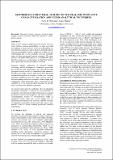| dc.contributor.author | McNamara, David D. | |
| dc.contributor.author | Massiot, Cécile | |
| dc.date.accessioned | 2017-08-14T10:37:41Z | |
| dc.date.available | 2017-08-14T10:37:41Z | |
| dc.date.issued | 2016-11-23 | |
| dc.identifier.citation | McNamara, David D. , & Massiot, Cécile. (2016). Geothermal structural geology in New Zealand: Innovative Characterisation and micro-analytical techniques Paper presented at the Proceedings 38th New Zealand Geothermal Workshop, Auckland, New Zealand. | en_IE |
| dc.identifier.uri | http://hdl.handle.net/10379/6718 | |
| dc.description.abstract | Many of New Zealand's geothermal reservoirs are hosted in rocks with low intrinsic permeability. As such, successful development of these resources relies on understanding the role subsurface structures, such as fractures and faults, play in reservoir permeability. Further complexity is added to this understanding due to the constantly evolving permeable nature of these geothermal reservoir structures. The same fractures and faults which operate as interconnected, open, fluid flow pathways, can also behave as fluid flow barriers due to geothermal mineral precipitation over time. Increased industry application of borehole logging technology, and the development of innovative geothermal data processing and interpretation, has allowed structural geologists to make advances in characterising the subsurface structure of the Taupo Volcanic Zone. These novel data reveal structural heterogeneity at a variety of scales, from changing dominant orientations across the Taupo Volcanic Zone, to decimetre changes in fracture orientation within a single well. Additionally, these techniques allow observation of the variability in in situ horizontal stress directions for the first time, revealing active subsurface structures. At a much smaller scale, the application of novel, advanced, microscopy techniques to analyse the micro-structure of geothermal vein minerals provides information on evolving geothermal reservoir fluid properties, and stress conditions. Crystallographic analysis of microstructures found in geothermal calcite veins can provide insight into the differential stress history of the reservoir, while the operation of temperature dependent, calcite crystal slip systems, may provide a tool to record evolving geothermal reservoir temperatures. | en_IE |
| dc.format | application/pdf | en_IE |
| dc.language.iso | en | en_IE |
| dc.publisher | International Geothermal Association | en_IE |
| dc.relation.ispartof | New Zealand Geothermal Workshop 2016 | en |
| dc.rights | Attribution-NonCommercial-NoDerivs 3.0 Ireland | |
| dc.rights.uri | https://creativecommons.org/licenses/by-nc-nd/3.0/ie/ | |
| dc.subject | Structural geology | en_IE |
| dc.subject | Fracture | en_IE |
| dc.subject | Borehole image logging | en_IE |
| dc.subject | Electron backscatter diffraction | en_IE |
| dc.subject | Fluid flow | en_IE |
| dc.subject | Calcite | en_IE |
| dc.subject | Quartz | en_IE |
| dc.subject | Scaling | en_IE |
| dc.title | Geothermal structural geology in New Zealand: Innovative characterisation and micro-analytical techniques | en_IE |
| dc.type | Conference Paper | en_IE |
| dc.date.updated | 2017-07-22T12:27:07Z | |
| dc.local.publishedsource | https://www.geothermal-energy.org/publications_and_services/conference_paper_database.html | en_IE |
| dc.description.peer-reviewed | peer-reviewed | |
| dc.contributor.funder | |~| | |
| dc.internal.rssid | 11991964 | |
| dc.local.contact | David Mcnamara, -. - Email: david.d.mcnamara@nuigalway.ie | |
| dc.local.copyrightchecked | Yes | |
| dc.local.version | PUBLISHED | |
| nui.item.downloads | 265 | |


